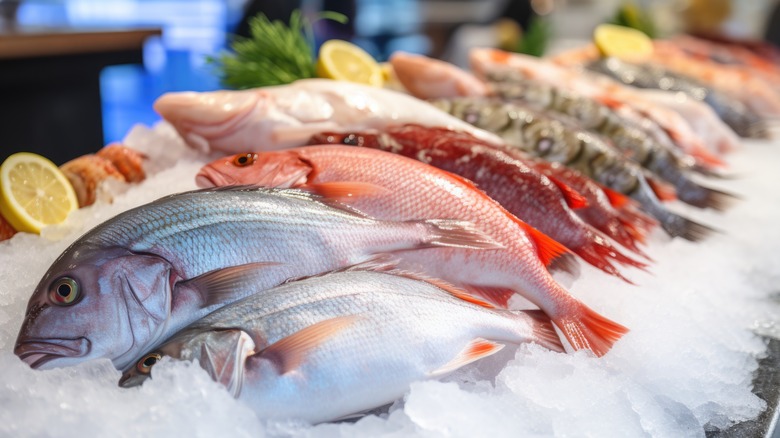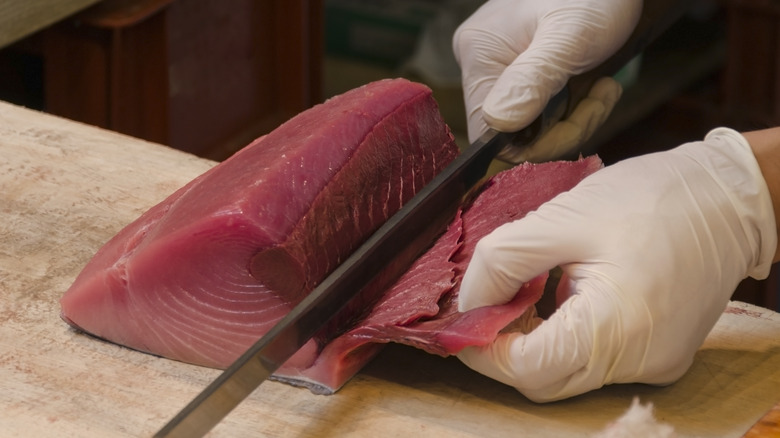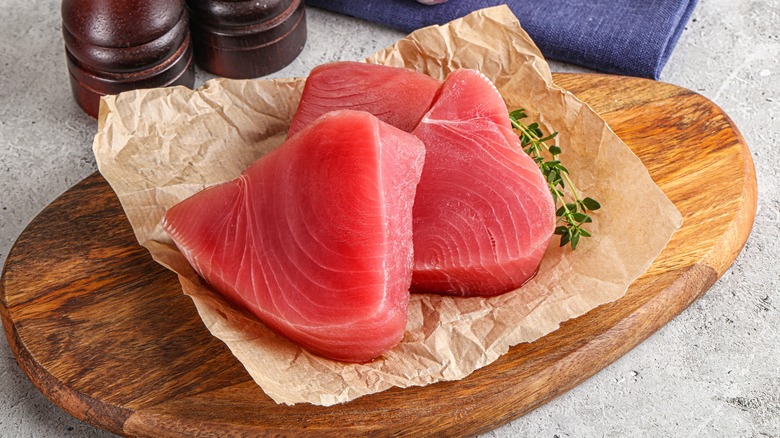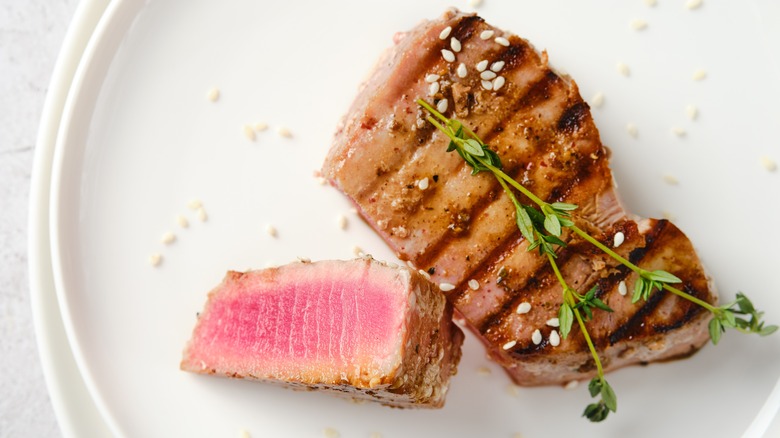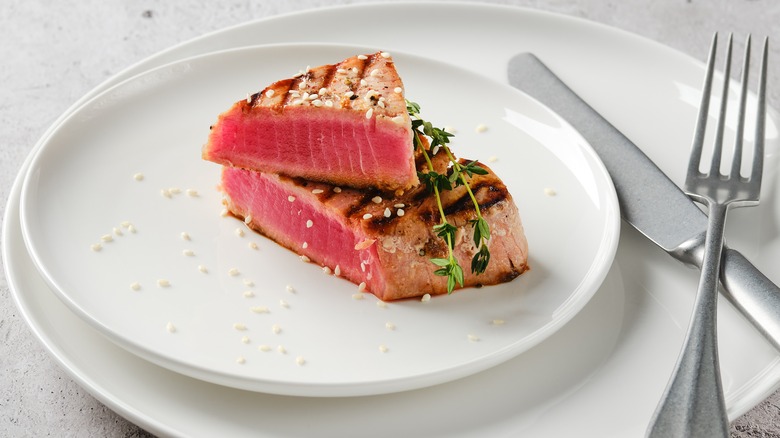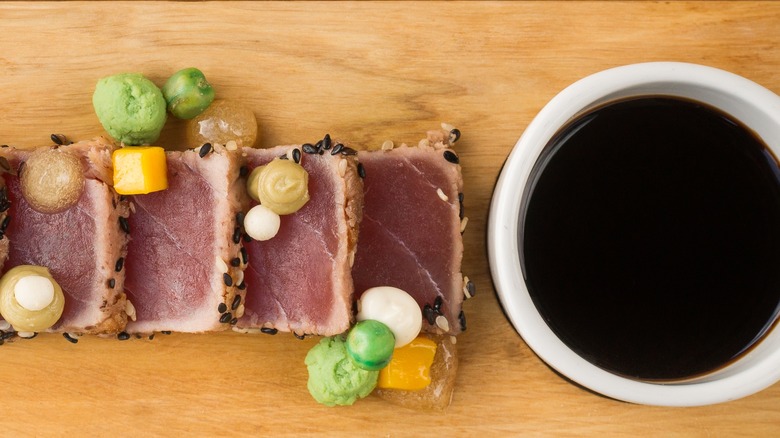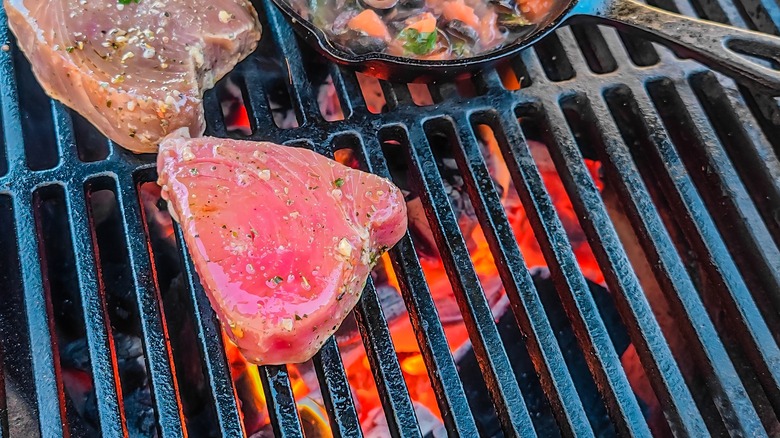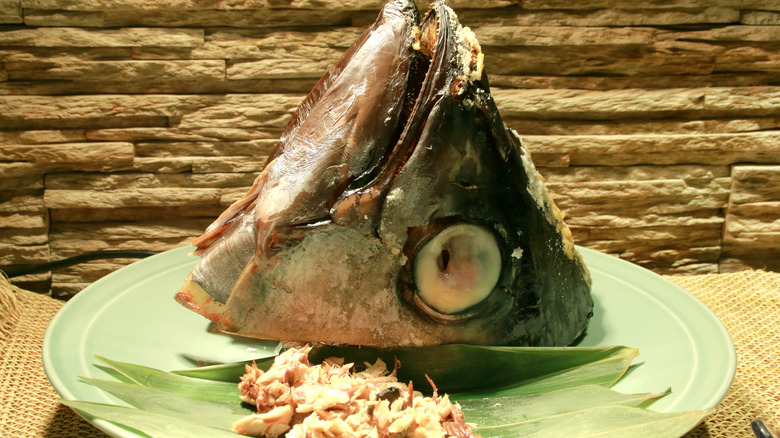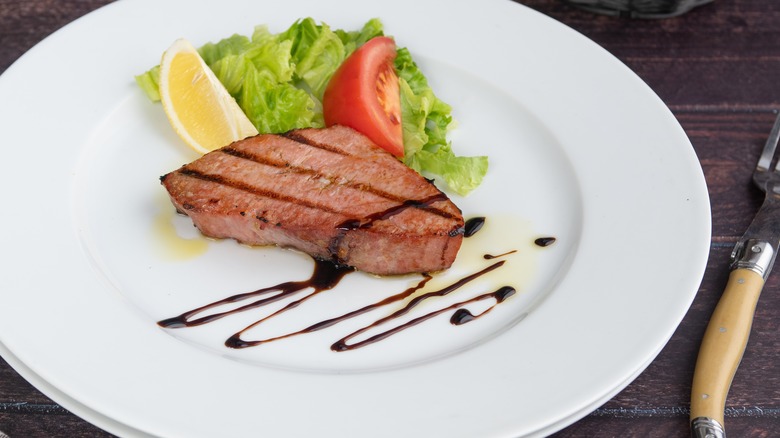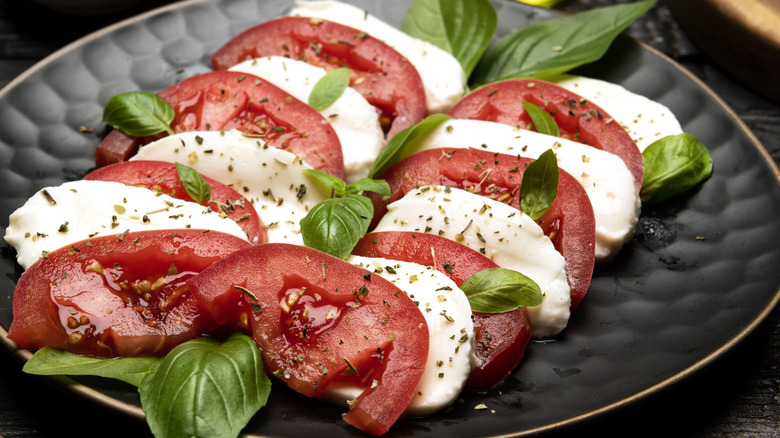Andrew Zimmern's Best Tips For Grilling Tuna Steaks
Tuna fish isn't just for salads and picnics, and you can do more than just smother it in mayo. Though most people enjoy this versatile seafood via the conveniently packaged variety, tuna is cooked before being canned, which limits your preparation options.
But there's another way to highlight what tuna fish has to offer. Grilled tuna steaks — a staple of the Polynesian islands — encompass the tastiest flavor profile for fresh-caught tuna. Also eaten raw in sushi or poisson cru, cuts of fresh tuna steak open up a number of possibilities for enjoying tuna fish that doesn't come out of a can. (If you're now wondering what to do with those cans of tuna in your pantry, check out the best canned tuna tips from celebrity chefs.)
To get the best advice about grilling tuna steaks, we could think of nobody better to ask than star chef and longtime fisher Andrew Zimmern. With his extensive culinary resume and philanthropy work, Zimmern has taken the food world by storm, racking up multiple James Beard Awards and Emmy honors along the way. Zimmern is an avid outdoorsman who loves cooking over an open fire, and he knows his way around tuna. We had the pleasure of discussing all things tuna with Zimmern, from catch to plate, so you can grill tuna like a pro.
Source high-quality tuna from a fishmonger
In order to master grilled tuna, you first need the right source. Andrew Zimmern tells us that the local grocery store is unlikely to have high-quality fresh tuna available, and advises that the best source for tuna steaks is a dedicated fishmonger. However, if you have access to Whole Foods or Erewhon, Zimmern says that you should be able to find quality tuna in the seafood sections of these upscale stores.
But Zimmern also offers a word to the wise about tuna sold in supermarkets. "Oftentimes it's treated with dyes or gassed, and you don't want to do that," Zimmern says. "Caveat emptor, right? Let the buyer beware."
What should the buyer be aware of, and how should you select the best tuna steak? Cuts from varied types of tuna have different coloring, ranging from deep red to pale pink. But no matter which tuna variety you've chosen for your next grilling adventure, avoid tuna steaks that are slimy, or if they have brown spots or excessive streaking. And your nose will know whether the fish is fresh or beyond the point of eating — tuna should have a slight scent of the ocean, but not smell overwhelmingly fishy.
Consider catching and cleaning your own tuna
Anyone able to catch their own tuna is playing in an entirely different ball game, according to Andrew Zimmern — especially if you clean and butcher your fish, too. Zimmern loves fishing for tuna in warmer waters, and tells us that "there is a black tuna that's just a remarkable fish. They grow to about 10, 15, 20 pounds." Even if you're not the one who caught the fish, but perhaps managed to land a fresh-caught tuna from a seafaring friend, Zimmern encourages learning how to butcher it yourself.
Similar to breaking down poultry, butchering a fish is an acquired skill. Zimmern gives us a brief overview of the technique: "Run a knife down the middle of the fillet, piercing the skin parallel to the center bone, and then removing all four panels on the sides." But in order to truly understand how to butcher tuna, Zimmern suggests watching an Outdoor Channel video filmed for his "Wild Game Kitchen" show, featuring the chef showing how to properly break down tuna.
Use thick steaks from fatty tuna
Whether you caught the tuna, butchered it yourself, or simply purchased tuna steaks from a reputable fishmonger, Andrew Zimmern suggests using fillets that are at least an inch thick, and from fatty fish. "You want your tuna to be as fatty as possible. That doesn't mean using the fattiest part of the tuna; that will just cause sooty flare-ups on your grill," Zimmern says.
The best tuna steaks will have a good balance of lean protein and fat, so your fish is tender, succulent, and won't dry out while grilling. "Sometimes I will buy a small loin of tuna — 3, 4, 5, pounds — and grill it the way that I would grill tenderloin and beef, and slice it at the table for people," Zimmern shares. "It's very dramatic."
But of course, you can grill fattier parts of the tuna, too. "If I do grill a collar of tuna or some chutoro or otoro — which are the fattiest cuts from the tuna belly — I will do those [over] indirect heat, so they don't have sooty flare-ups," Zimmern says. Most importantly, the chef advises us that no matter what cut you're grilling, first "let your tuna come to room temperature."
Oil your tuna steak so it doesn't stick to the grate
One of the main concerns when it comes to grilling fish is its tendency to get stuck on the grate, and subsequently losing much of it to the fire below. For this reason, there are many online tips for cooking fish on a grill. While these hacks include everything from using banana leaves as a grilling base to wrapping the fish in bacon, Andrew Zimmern's best advice is to use a clean grill and cooking oil. "As long as your tuna is oiled — but nothing dripping off it, just brushed on — and as long as your grill grates are clean, and I always oil my grates right before I put anything on them, you'll be in great shape," the chef says.
There are a number of cooking fats to choose from for grilling tuna. If you're cooking over high heat, consider fats with high smoke points, such as avocado oil, ghee, refined coconut oil, or extra light olive oil. Match your cooking fat to the rest of your recipe to keep the flavors in harmony — for example, coconut oil and olive oil complement citrus and spice, while ghee goes well with dill and peppers. For best results, brush the fat on both your grill grates and tuna before grilling.
Grill tuna steaks over wood fire for best results
You can prepare tuna on any type of grill that produces fire, but you'll achieve enhanced layers of flavor from tuna steak if you grill it over wood. This imparts a light smokiness to tuna's brightness, creating contrasting-yet-compatible savory profiles. Grilling over wood also brings you one step closer to nature. Andrew Zimmern grills food the way our ancestors did — over a large firepit — and while he strongly prefers cooking over wood, he says that you can also use a gas grill for tuna steaks.
When grilling tuna steaks, "I would crank [the heat] up as high as possible and grill it," Zimmern says, noting that this applies to wood- or gas-fired grills. However, when other cuts of tuna are involved, Zimmern points out that a gas grill can have a useful feature. "If it's a fatty piece from the belly, I would grill it over indirect heat by turning off some of the propane vents, which is an option you have on most gas grills," he says.
Using a mild type of fruit wood, such as apple or cherry, will lend additional flavor to your tuna. Check out some of the best types of wood to use for grilling to find a delicious match for tuna steaks that suits your taste preferences.
Save your seasonings for when you're done grilling
While it has a hearty flavor, fresh tuna delivers a refreshingly light taste that's often best appreciated with minimal accompaniments. Nonetheless, it's possible to add spices or sauces after the fish is grilled, allowing you to savor tuna's essence along with your preferred seasonings.
Andrew Zimmern likes to grill tuna with only one seasoning: salt. "That is it. I like to high-heat sear my tuna very close to the grill, so I get that black-and-blue effect. And sometimes I just brush it with a little bit of vegetable oil and salt. And then I season it afterward." And what seasonings go best with grilled tuna steaks? "To me, there's nothing better than a mixture of soy sauce [and] lemon juice," Zimmern confides.
Soy sauce and lemon juice are two ingredients that are frequently paired with fish to contribute umami and zing. But other flavorings that go well with tuna steak recipes include hot, sweet, and tangy ingredients, such as chili peppers, orange zest, mirin, and lime. However, simple is often best, and salt is all you really need to dress up tuna steaks.
Sear quickly over high heat, but leave the center rare
One of the great things about tuna is that it can be prepared and eaten in multiple ways, from tuna tartare — a popular dish of diced raw tuna — to grilled tuna steaks. Tuna's versatility makes it perfect to use as an ingredient in a number of different meals, like as a topping for salads, as a base for chowders, or when shining as a main-course fillet.
According to Andrew Zimmern, one of the most pleasing ways to eat tuna is when it's grilled rare. More specifically, blue rare — also called seared rare or black-and-blue. "The idea is that you want to serve your tuna seared well on the outside, but still cold, rare on the inside," the chef says. This means that tuna steak should be cooked quickly over high heat, so the outside crisps up and the inside remains nearly raw. The trick, Zimmern shares, is controlling the heat. "The fattier the cut of anything, I go indirect; the leaner the cut, I go direct over high heat."
The simple way to tell when tuna steaks are done grilling is to keep an eye on the exterior color of your steak. Raw tuna is red or pink, but when it hits the heat, it turns beige or light gray. A quick sear over high heat will caramelize the tuna steak's surface, turning it a luscious golden brown. This happens within only a few minutes.
Create a sauce for dipping your tuna steak
Since tuna steak shines on its own without a lot of supplementary seasoning, accompanying sauces can be tuna's best complement. A dipping sauce provides a great way to enhance tuna in a manner that gives every diner control over how much flavoring to add.
There are a number of ingredient combinations that create a tasty sauce for dunking tuna. Andrew Zimmern explained that his favorite dipping sauce for tuna steak is a mixture of soy sauce and fresh lemon juice in a 2:1 ratio — but he emphasizes that this should be made with "a really good, naturally brewed soy sauce."
The sauce ingredients don't end there. Zimmern also grates a generous amount of daikon radish, squeezing some of the juice out, and then mixes the shredded daikon with togarashi (a Japanese spice blend) and scallions. "Then I put that in little bowls for people to dip into when you pour the soy sauce and lemon juice in, just to moisten that grated daikon. I love dipping tuna into that sauce," Zimmern effuses.
No need to use special accessories or equipment
Many tips for grilling seafood include using accessories geared toward accommodating the delicate nature of fish. Myriad cooking utensils exist to make life easier for manning the grill at home, and fish-ware spans from spatula tongs to grill baskets. Options range from grilling tuna in a steel mesh enclosure to placing a pan on top of the grates, all in an attempt to gently handle your grilling fish so that it doesn't disintegrate or go up in fishy flames. Some folks may even wrap tuna in foil (please, don't), hoping to keep it in one piece.
We asked Andrew Zimmern for the best method to grill tuna steaks so that you don't destroy a good fillet of fish. "You can go directly on your grilling grates. You don't need a grill basket. You don't need cast iron," Zimmern replies. "This fish does not need to be wrapped for grilling. The great thing about tuna — like swordfish, sharks, ... other steak fish — you just need a spatula."
Leave your comfort zone and try all parts of tuna
While not all parts of tuna can be filleted for steak, many segments of tuna are delicious when cooked. Consider experimenting beyond the usual steak cut, and expand your palate to include less-appreciated parts, such as tendons, bloodline, or the head. During one of Andrew Zimmern's "Bizarre Foods" episodes on Travel Channel, he learned that tuna tendons become tender and tasty when deep-fried, and that the tuna bloodline — usually something that chefs throw away — tastes like beef when prepared correctly; you only need to cook it for a few minutes.
Zimmern shares his top way to experience the variety of tastes and textures that tuna embodies: "I think the coolest thing — especially if you're lucky to get a large species of tuna that's sustainable, like a big yellowfin tuna — is to roast the head whole." This may be a little unorthodox, but as Zimmern points out, "there are so many pockets of meat all over that head and neck. ... Just rub it with salt and roast it whole, and pull it apart like a giant turkey and eat it." Roasted tuna head can be a large delicacy that presents an opportunity to share a rare dining experience with others — which, for Zimmern, is one of the greatest joys in eating.
Keep tuna steak simple
In order to delight in tuna steaks that melt in your mouth, it's best to focus on the grilling technique and not worry about spices, which could actually be detrimental to your dish. Overloading tuna with too many other ingredients can detract from the fish and hide its true quality, as Andrew Zimmern impresses upon us. "Keep it as simple as possible. Just brush your pieces of fish with oil, season them with salt, and then provide complementary sauces." Master the art of grilling tuna, and your accompaniments will be a delicious bonus for your meal.
Tuna itself provides such a range of taste and texture that combining and serving grilled tuna in multiple ways can surprise both you and your guests. Zimmern highlights a tuna dish by featuring charred tuna collar alongside raw tuna. This way, the contrasting-yet-complementary parts wow the senses. "The roasted flavor of tuna collar almost needs no other accessory at the table," Zimmern says, praising the contrast provided when this cooked part is paired with raw tuna specialties. "I think you have two different tastes that, to my mind, is the best way to enjoy tuna."
Serve light side dishes with your tuna steak
Just like how you want to keep tuna steak simple and not overdo it with herbs and spices, don't throw a shadow over your perfectly grilled fish by swamping it with heavy sides. Grilled tuna pairs nicely with side dishes like rice, sautéed vegetables, and green salads, since each component supports tuna's brightness. Andrew Zimmern suggests serving tomatoes and mozzarella — offering light acidity and sweetness, along with the cheese's rich creaminess — as a wonderful combination with grilled tuna steaks.
While numerous grilled tuna recipes offer the opportunity to try something new (like grilled teriyaki tuna and mushroom skewers), we recommend trying what this star chef thinks is the ultimate way to serve grilled tuna, utilizing the aforementioned dipping sauce and pairing it with simple sides. "That grated daikon sauce is just spectacular, both for the grilled tuna served rare and the collar," says Zimmern. "I frequently will do the two together with rice, greens, and salad, and that incredible sauce to dip into. And there's just absolutely nothing better, in my opinion."

